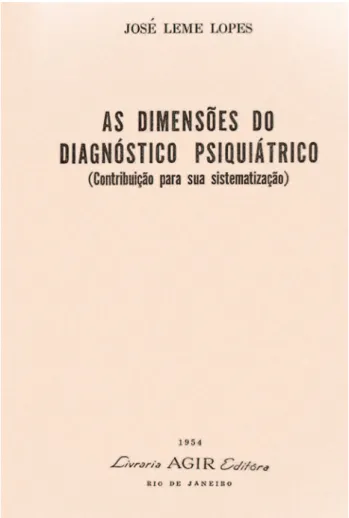EDITORIAL
Sixty years (1954-2014) of Jose´ Leme Lopes’s
fundamental book:
As dimenso˜es do diagno´stico
psiquia´trico
Antonio E. Nardi
Editor-in-Chief, Revista Brasileira de Psiquiatria, Panic & Respiration Laboratory, Institute of Psychiatry, Universidade Federal do Rio de Janeiro (UFRJ), Rio de Janeiro, RJ, Brazil. National Science and Technology Institute for Translational Medicine (INCT-TM), Conselho Nacional de Desenvolvimento Cientı´fico e Tecnolo´gico (CNPq), Brazil.
At a time when psychiatric diagnosis is again being questioned as to its validity and to the harm it might cause when improperly used,1we must turn our attention to the pillars of diagnostic precision. Among the various psychiatric researchers that emerged in the 20th century dealing with the medical model, Jose´ Leme Lopes (1904-1990) stands out for his fundamental work. His important scientific contribution was the main subject of his 1954 thesis, published as a book in the same year (Figure 1): The dimensions of psychiatric diagnosis (contribution to its systematization).2At the time, his idea of psychiatric diagnosis was a new multi-axial conception, which would earn him a well-deserved homage and broad recognition abroad for the role it would play in the formulation of new nosological classifications suggested by the World Health Organization and by the American Psychiatric Association. The important contribution of this book was further recognized internationally when its original cover page was reproduced in the 6th edition of Kaplan & Sadock’sComprehensive textbook of psychiatry.3 Leme Lopes fought for a scientific psychiatry with ties to medicine and taking into account the contribution of other aspects of human thought.
In his book, Leme Lopes presented the difficulties in precise psychiatric diagnosis as a main problem of our clinical and research practice. Diagnosis is the funda-mental process in all medical practice, and psychiatry could not be different. The dimensions of psychiatric diagnosiswas republished and updated in 1980.4In this edition, the book has 10 chapters, only the first five of which belonged to the original edition. The original five chapters are: ‘‘The vicissitudes of psychiatric diagnosis’’; ‘‘The dissolution of the diagnosis’’; ‘‘The reconstruction of the diagnosis’’; ‘‘The development of the diagnostic problem’’; and ‘‘Diagnosis nowadays.’’ The updated edition had five more chapters: ‘‘The diagnostic evalua-tion’’; ‘‘Standard diagnostic interviews’’; ‘‘The diagnostic dimensions and the dynamic pluridimensional diagnosis’’; ‘‘The diagnosis procedure’’; and ‘‘The ICD-9.’’
Throughout the book, one can recognize the tremen-dous psychopathological, philosophical, and scientific background of Leme Lopes. He magnificently mastered each point of the validity of psychiatric diagnosis. The psychiatric interview, the history of symptoms, the psychopathological and physical examinations, the
Correspondence: Antonio E. Nardi, Laboratory of Panic & Respiration, Institute of Psychiatry, Universidade Federal do Rio de Janeiro (UFRJ), Rua Visconde de Piraja´, 407/702, CEP 22410-003, Rio de Janeiro, RJ, Brazil.
E-mail: antonioenardi@gmail.com
Figure 1 Title page of Leme Lopes’s 1954 book As dimenso˜es do diagno´stico psiquia´trico (contribuic¸a˜o para sua sistematizac¸a˜o), or The dimensions of psychiatric diagnosis (contribution to its systematization)
Revista Brasileira de Psiquiatria. 2014;36:1–2
ß2014 Associac¸a˜o Brasileira de Psiquiatria
syndrome, the family and personal history, and the laboratory workup were all precisely described in terms of their importance and proper place to achieve the best possible validity. Leme Lopes also emphasized cultural features and long-term follow-up as crucial aspects.
Leme Lopes stands beside other pillars of psychiatric diagnosis research, such as Emil Kraepelin, Kurt Schneider, Adolf Meyer, and Henry Ey.5His contribution to the study of diagnosis must be highlighted whenever its validity is questioned.
Acknowledgements
This report was supported by Conselho Nacional de Desenvolvimento Cientı´fico e Tecnolo´gico (CNPq) and the National Science and Technology Institute for Translational Medicine (INCT-TM).
Disclosure
The author reports no conflicts of interest.
References
1 Nardi AE, Kapczinski F, Quevedo J, Hallak JE, Freire R, Romano-Silva MA. The quest for better diagnosis: DSM-5 or RDoC? Rev Bras Psiquiatr. 2013;35:109-10.
2 Leme Lopes J. As dimenso˜es do diagno´stico psiquia´trico (con-tribuic¸a˜o para sua sistematizac¸a˜o). Rio de Janeiro: Agir; 1954. 3 Mezzich JE. International perspectives on psychiatric diagnosis. In:
Sadock BJ, Kaplan HI. Comprehensive textbook of psychiatry 6th ed. Baltimore: Williams & Wilkins; 1995. p. 692-703.
4 Leme Lopes J. Diagno´stico em psiquiatria. Rio de Janeiro: Cultura Me´dica; 1980.
5 Nardi AE, Hallak JE, Crippa JA. Prof. Jose´ Leme Lopes (1904-1990): the pioneer of the multi-axial diagnosis. Arq Neuropsiquiatr. 2010; 68:479-80.
AE Nardi
2
